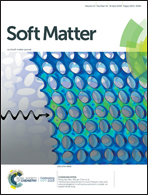Preparation of near-infrared laser responsive hydrogels with enhanced laser marking performance†
Abstract
Polystyrene modified bismuth oxide particles (PS@Bi2O3) were prepared and characterized by Fourier transform infrared spectroscopy (FT-IR) and scanning electron microscopy (SEM). Using acrylamide (AM) as a monomer, and PS@Bi2O3 as laser sensitive additives, PAM/PS@Bi2O3 hydrogels were fabricated and treated by a 1064 nm near-infrared laser. The laser responsive properties of PAM/PS@Bi2O3 hydrogels were investigated at different current intensities and loading content of PS@Bi2O3 by visual observation, optical microscopy, and SEM, and the mechanism of laser response was analyzed by XRD and Raman spectroscopy. The results indicate that the PAM hydrogel with added PS@Bi2O3 particles showed excellent response to the laser, and high contrast and resolution text and pattern marks on the hydrogel surface can be obtained. The selection of suitable laser current intensity is key to the laser response of the PAM/PS@Bi2O3 composite hydrogel. Through analysis of XRD, Raman spectroscopy, and TGA data, the laser marking of the PAM/PS@Bi2O3 hydrogels originates from the generation of both bismuth metal and amorphous carbonized materials. After adding PS@Bi2O3 with a loading content from 1% to 3%, the mechanical properties of the hydrogels were improved, but the swelling properties were finally decreased.



 Please wait while we load your content...
Please wait while we load your content...